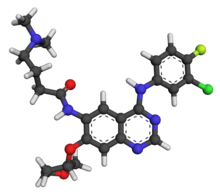Afatinib
 | |
 | |
| Clinical data | |
|---|---|
| Trade names | Gilotrif, Giotrif, Afanix |
| Other names | BIBW 2992 |
| AHFS/Drugs.com | Monograph |
| MedlinePlus | a613044 |
| License data | |
| Pregnancy category |
|
| Routes of administration | By mouth |
| ATC code | |
| Legal status | |
| Legal status | |
| Pharmacokinetic data | |
| Protein binding | 95% |
| Metabolism | CYP not involved |
| Elimination half-life | 37 hours |
| Excretion | Faeces (85%), urine (4%) |
| Identifiers | |
| |
JSmol) | |
| |
| |
| | |
Afatinib, sold under the brand name Gilotrif among others, is a medication which is used to treat
It is mainly used to treating cases of NSCLC that harbour mutations in the epidermal growth factor receptor (EGFR) gene.[6]
It is on the World Health Organization's List of Essential Medicines.[7]
Medical uses
It has received regulatory approval for use as a treatment for non-small cell lung cancer,[1][5][8][9] although there is emerging evidence to support its use in other cancers such as breast cancer.[10]
Adverse effects
Adverse effects by frequency include:[1][5][8][9][11]
- Very common (>10% frequency)
- Diarrhea (>90%)
- Rash/dermatitis acneform
- Stomatitis
- Paronychia
- Decreased appetite
- Nose bleed
- Itchiness
- Dry skin
- Common (1–10% frequency)
- Dehydration
- Taste changes
- Dry eye
- Cystitis
- Cheilitis
- Fever
- Runny/stuffy nose
- Low amount of potassium in the blood
- Conjunctivitis
- Increased ALT
- Increased AST
- Hand-foot syndrome
- Muscle spasms
- Kidney impairment and/or failure
- Uncommon (0.1-1% frequency)
Mechanism of action
Like
Clinical trials
In March 2010, a Phase III trial in NSCLC patients called Lux-Lung 5 began with this drug.[14] Fall 2010 interim results suggested the drug extended progression-free survival threefold compared to placebo, but did not extend overall survival.[15] In May 2012, the Phase IIb/III trial Lux-Lung 1 came to the same conclusion.[16]
In January 2015, a Phase III trial in people with NSCLC suggested the drug extended life expectancy in stage IV NSCLC adenocarcinoma with EGFR Mutation type del 19-positive tumors, compared to cisplatin-based chemotherapy by a year (33 months vs. 21 months).[17] It also shows strong activity against exon 18 mutations (particularly G719) and is currently the preferred EGFR-TKI therapy for exon 18 mutations (particularly G719x).[18][verification needed]
Phase II results for breast cancer that over-expresses the protein
Society and culture
Brand names
In Bangladesh under the trade name Afanix.
References
- ^ a b c d "Gilotrif (afatinib) tablet, film coated". DailyMed. Boehringer Ingelheim Pharmaceuticals, Inc. 18 October 2019. Retrieved 4 November 2020.
- ^ Spreitzer H (13 May 2008). "Neue Wirkstoffe – Tovok". Österreichische Apothekerzeitung (in German) (10/2008): 498.
- ^ PMID 19037840.
- ^ "Gilotrif (afatinib)" (PDF). US Food and Drug Administration. Retrieved 11 March 2021.
- ^ a b c d "Giotrif Afatinib (as afatinib dimaleate)" (PDF). TGA eBusiness Services. Boehringer Ingelheim Pty Limited. 7 November 2013. Retrieved 28 January 2014.
- PMID 29225480.
- hdl:10665/345533. WHO/MHP/HPS/EML/2021.02.
- ^ a b "Giotrif 20 mg film-coated tablets – Summary of Product Characteristics (SPC)". electronic Medicines Compendium. Boehringer Ingelheim Limited. 20 January 2014. Retrieved 28 January 2014.
- ^ a b "Giotrif : EPAR -Product Information" (PDF). European Medicines Agency. Boehringer Ingelheim International GmbH. 16 October 2013. Retrieved 28 January 2014.
- ^ PMID 22418700.
- ^ "Gilotrif (afatinib) dosing, indications, interactions, adverse effects, and more". Medscape Reference. WebMD. Retrieved 28 January 2014.
- PMID 18408761.
- ^ Schubert-Zsilavecz, M, Wurglics, M, Neue Arzneimittel Frühjahr 2013. (in German)
- ^ Clinical trial number NCT01085136 for "LUX-Lung 5: BIBW 2992 Plus Weekly Paclitaxel Versus Investigator's Choice of Single Agent Chemotherapy Following BIBW 2992 Monotherapy in Non-small Cell Lung Cancer Patients Failing Erlotinib or Gefitinib" at ClinicalTrials.gov
- ^ "Afatinib (BIBW 2992*) Triples Progression Free Survival in Phase III Study in Lung Cancer Patients" (Press release). BusinessWire. 11 October 2010.
- PMID 22452896.
- PMID 25589191.
- PMID 26206867.
- PMID 22763464.
External links
![]() Media related to Afatinib at Wikimedia Commons
Media related to Afatinib at Wikimedia Commons
- "Afatinib". Drug Information Portal. U.S. National Library of Medicine.
- "Afatinib dimaleate". Drug Information Portal. U.S. National Library of Medicine.
